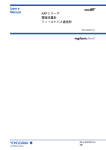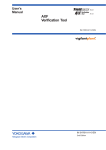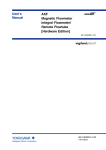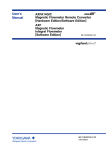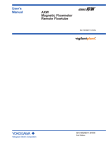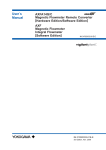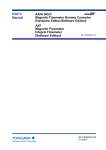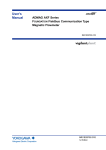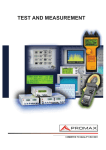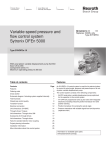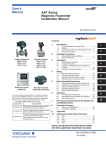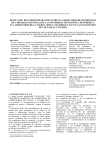Download AM012 - Yokogawa
Transcript
User's Manual Models AM012 Magnetic Flowmeter Calibrator MANUAL AMENDMENT IM 1E6K2-10E User’s manual IM1E6K2-E (6th Edition) is amended for the calibration of AXFA11, AXFA14 and AXF integral flowmeter. Page Contents Page 2-1-1 2-1 Model Name and Specifications Data plate description is changed Page 3-1 3 GENERAL ADMAG AXF Magnetic Flowmeter is added Page 3-2-1, 3-2-2 3-1 Standard Specifications 3-2 Model and Suffix Codes 3-3 Options 3-4 Accessories Page 3-3-1 3-5 External Dimensions Page 4-1-1 4 Operation Page 4-19-1, 4-19-2, 4-19-3, 4-19-4 4-7 When AM012 is used with AXFA11 Page 4-19-5, 4-19-6, 4-19-7, 4-19-8, 4-19-9 4-8 When AM012 is used with AXFA14 or AXF integral Flowmeter Page 3-2-1, 3-2-2 3.1 Standard Specifications Page 3.2 3.3 3.4 3-2-2 Model and Suffix Codes Options Accessories Page 3-3-1 3.5 External Dimensions Page 4-19-10 to 4-14-16 4.9 When AM012 is used with FOUNDATION Fieldbus Communication type AXFA14 or AXF integral flowmeter Junction box for ADMAG AXF (optional code / AXF) is added Junction box for AXFA14 and AXF integral flowmeter is added Calibration Procedures for AXFA11, AXFA14 and AXF integral flowmeter are added AXFA11 calibration is added AXFA14 and AXF integral flowmeter calibration is added Junction box for FOUNDATION Fieldbus Communication type is added Junction box for FOUNDATION Fieldbus Communication type (optional code /FB) is added Junction box for FOUNDATION Fieldbus Communication type is added Calibration procedures for FOUNDATION Fieldbus Communication type AXFA14 or AXF integral flowmeter are added 13th Nov. 2006 Yokogawa Electric Corporation IM 1E6K2-10E 2nd Edition 2. HANDLING PRECAUTIONS AND REQUISITES 2. HANDLING PRECAUTIONS AND REQUISITES The Model AM012 Magnetic Flowmeter Calibrator is thoroughly tested at the factory before shipment. However, when the instrument is delivered, make a visual check to ascertain that no damage occurred during shipment. This section describes important precautions and requisites to be observed when handling the instrument. Carefully read this manual before using the instrument. If there are any problems or questions, please contact the nearest YOKOGAWA service center or the dealer from whom the instrument was purchased. 2.1 Model Name and Specifications The Model name and main data are indicated on the name plate attached at the rear of the case (see Figure 2.1). CALIBRATOR MODEL *A SUPPLY AM01290-132VAC 47-63Hz 180 — 264V AC at 200V series NO. Made in Figure 2.1 Data Plate Verify that the data are the same as those specified at the time when it was ordered, referring to the Model and Suffix Codes in Section 3.2. When contacting us, please indicate the Model and the instrument serial number. 2.2 Handling and Storing Precautions and Requisites Precautions and requisites to be taken when handling and storing this instrument: (1) Prevent excessive shock to the instrument. (2) Protect the instrument from water and precipitation. (3) Calibrate the instrument at normal temperature and humidity. (4) Avoid installation or storage of the instrument in a corrosive atmosphere. (5) Store the instrument in a location: • free from water and precipitation. • relatively free from vibration and shock. • where the ambient temperature is between 0°C and 40°C and the humidity is between 5% and 80% relative humidity (well-ventilated and without condensation). IM 1E6K2-E 2-1-1 3. GENERAL 3. GENERAL The AM012 Calibrator is a standard signal generator used to check or calibrate the ADMAG AXF Magnetic Flowmeter (AXFA11, AXFA14, AXF Integral Flowmeter), AM11 Magnetic Flow Converter, ADMAG AE Magnetic Flowmeter, ADMAG CA Magnetic Flowmeter, AM12 Magnetic Flow Converter, AM100A/B or AM200A/B Magnetic Flowmeter, YMA11 Magnetic Flow Converter and Compact YEWMAG Magnetic Flowmeter (CYM for short), styles A and B.(Style A or style B is indicated on the name plate: style A as *A and B as *B.) The excitation load is incorporated in the calibrator, so the converter can be checked or calibrated without using a flow detector. Span can be set from 0 to 10.99 m/s. The output signal related to the span can be set to 0, 25, 50, 75 and 100% using the output (%) knob. 3.1 Standard Specifications ● AM012 Case : Material : Unsaturated polyester resin Dimensions : 110mm (H)×235mm (W)×364mm (D) Color : Light grayish green Wiring cable : Special cables supplied are: AM012 power cord, signal and excitation cables CYM signal cable and excitation cable (optional) Range setting : 0 to 10.99 m/s (minimum scale 0.01 m/s) with the spansetting dial. CHECK, 0, 25, 50, 75, 100% with output (%) knob. Accuracy : ±0.04% of set value (span 0.1 m/s or greater) +0.04 mm/s (span less than 0.1 m/s) Power supply requirements : 90 to 132 V AC or 180 to 264 V AC, 47 to 63 Hz Ambient temperature limits : 0 to 40°C Weight : 4.2kg Power cord plug : Three types of plugs are available (select any one of the following three): (–1) For 100 V AC (for domestic use) (–2) For 100 V AC (UL Standard) (–3) For 200 V AC (CEE Standard) (–1) 100 V series (for domestic use) Figure 3.1 IM 1E6K2-E (–2) 100 V series (conforms to UL standard) (–3) 200 V series (conforms to CEE standard) Power Cord Plugs 3-1 3. GENERAL ● Junction box for ADMAG AE and ADMAG CA Case : Material : Stainless steel Dimensions : 140.5mm(H)×112.4mm(W)×112.4mm(D) Color : Light gray Power supply requirements : Power supply code -A1; Range 80 to 264V AC, 47 to 63Hz/100 to 130V DC, Power supply code -D1; Range 20.4 to 28.8 V DC (except /FB of ADMAG AE) Ambient temperature limits : 0 to 40°C Weight : 1kg ● Junction box for ADMAG SE Case : Material : Stainless steel Dimensions : 140.5mm(H)×112.4mm(W)×112.4mm(D) Color : Light gray Power supply requirements : Power supply code -A1; Range 80 to 127 V AC, 47 to 63 Hz/90 to 110 V DC Power supply code -A2; Range 180 to 264 V AC Power supply code -D1; Range 20.4 to 28.8 V DC/AC Ambient temperature limits : 0 to 40°C Weight : 1kg ● Junction box for AXFA14 and AXF integral flowmeter Case : Material : Aluminum diecast Dimensions : 240mm(H)×180mm(W)×145.5mm(D) Color : Silver gray Power supply requirements : Power supply code 1; • AC specifications Rated power supply: 100 to 240 V AC, 50/60 Hz (Operating voltage range: 80 to 264 V AC) • DC specifications Rated power supply: 100 to 120 V DC (Operating voltage range: 90 to 130 V DC) Power supply code 2; • AC specifications Rated power supply: 24 V AC, 50/60 Hz (Operating voltage range: 20.4 to 28.8 V AC) • DC specifications Rated power supply: 24 V DC (Operating voltage range: 20.4 to 28.8 V DC) Ambient temperature limits : 0 to 40°C Weight : 2.7kg ● Junction box for FOUNDATION Fieldbus Communication type AXFA14 and AXF integral flowmeter Case : Material : Aluminum diecast Dimensions : 197mm(H)×180mm(W)×145.5mm(D) Color : Silver gray Power supply requirements : Power supply code 1; • AC specifications Rated power supply: 100 to 240 V AC, 50/60 Hz (Operating voltage range: 80 to 264 V AC) • DC specifications Rated power supply: 100 to 120 V DC (Operating voltage range: 90 to 130 V DC) Power supply code 2; 3-2-1 IM 1E6K2-E • AC specifications Rated power supply: 24 V AC, 50/60 Hz (Operating voltage range: 20.4 to 28.8 V AC) • DC specifications Rated power supply: 24 V DC (Operating voltage range: 20.4 to 28.8 V DC) Ambient temperature limits : 0 to 40°C Weight 3.2 : 2.7kg Model and Suffix Codes Model Suffix Code AM012 ........................ -1..................... Power code -2..................... -3..................... Style code *A.............. 100 V version (Type JIS plug) 100 V version (Type UL plug) 200 V version (Type CEE plug) Options With cable for CYM With junction box for AE and CA With junction box for SE With junction box for AXFA14 and AXF integral Flowmeter With junction box for FOUNDATION Fieldbus Communication type AXFA14 and AXF integral Flowmeter /CYM /AE /SE /AXF /FB 3.3 Description Magnetic flowmeter calibrator Style A Options CYM cables : Signal and excitation cables for CYMs (option code CYM) are available optionally to calibrate the Compact YEWMAG. Junction box for ADMAG AE and ADMAG CA: Junction box are available optionally to calibrate the ADMAG AE and ADMAG CA. Junction box for ADMAG SE: Junction box are available optionally to calibrate the ADMAG SE. Junction box for ADMAG AXF: Junction box are available optionally to calibrate the AXFA14 and AXF integral flowmeter. Junction box for FOUNDATION Fieldbus Communication type ADMAG AXF: Junction box are available optionally to calibrate the FOUNDATION Fieldbus Communication type AXFA14 and AXF integral flowmeter. 3.4 Accessories • • • • • One power supply cord (types of plugs vary depending on MS code.) One fuse (0.2 A) One signal cable One excitation cable Cable for CYM (When /CYM is selected) The cables and a fuse are stored in a cord container on the rear panel. To open the container cover, pull the container cover knob forward. • Junction box (When /AE, /SE, /AXF or /FB is selected) • Special cable for ADMAG SE (When /SE is selected) 3-2-2 IM 1E6K2-E 3. GENERAL 3.5 External Dimensions ●AM012 unit : mm(approx,inch) 364(14.3) 235(9.3) 100(3.9) 10(0.4) ●Junction box (for AE & CA) Junction box (for SE) 140.5(5.5) 140.5(5.5) 112.4(4.4) 112.4(4.4) 112.4(4.4) 112.4(4.4) ●Junction box (for AXFA14 and AXF integral flowmeter) 71(2.8) 240(9.45) 103(4.06) 66(2.6) 145.5(5.73) 57(2.24) 49(1.92) ø128(5.04) 180(7.09) ø87(3.43) ●Junction box (for FOUNDATION Fieldbus Communication type AXFA14 and AXF integral flowmeter) 197(7.76) 103(4.06) 180(7.09) 66(2.6) 145.5(5.73) 57(2.24) 49(1.92) 28(1.1) ø87(3.43) IM 1E6K2-E 3-3-1 3. GENERAL 3.6 Component Identification (Rear Panel) Function Switch Excitation Connector Output (%) Knob Ground Terminal Cord Container Cover Output Signal Connector Span-Setting Dial Power Supply Connector Exciting Current Polarity Indicator Figure 3.6 Component Identification 3-3-2 IM 1E6K2-E 4. OPERATION 4. OPERATION This chapter describes calibration procedures when the AM012 calibrator is used with: AM11(in Section 4.1), ADMAG AE, ADMAG CA(in Section 4.2), ADMAG SE(in Section 4.3), AM12, AM100A/B, AM200A/B(in Section 4.4), YMA11(in Section 4.5), Compact YEWMAG (CYM)(in Section 4.6), AXFA11(in Section 4.7), AXFA14 and AXF integral flowmeter(in Section 4.8). Refer to each section to perform the desired calibration. IMPORTANT • As a rule, calibration of the converter should be implemented in a maintenance service shop where the necessary tools are provided. • The amplifier unit contains sensitive parts that may be damaged by static electricity. Excercise care so as not to directly touch the electronic parts or circuit patterns on the board, for example, by preventing static electrification by using grounded wrist straps when handing the unit. Also take precautions such as placing a removed amplifier unit into a bag with an antistatic coating. 4.1 When AM012 is used with AM11 4.1.1 Interconnections Turn the AM11 power OFF. Disconnect the signal and excitation wirings for the AM11. Connect the signal and excitation cables to the AM012. Connect the power and ground cords to the AM012. (Ground the AM012 to prevent it from being affected by external noises. After turning the power on, let the instrument warm up for at least ten minutes.) Proceed to 4.1.2 Checking Procedure. (Shield) (Shield) (White) (White) (Black) (Black) Figure 4.1.1 Interconnection Diagram IM 1E6K2-E 4-1-1 4. OPERATION 4.7 When AM012 is used with AXFA11 4.7.1 Interconnections Turn the AXFA11 power OFF. Disconnect the signal and excitation wirings for the AXFA11. Connect the signal and excitation cables to the AM012. (refer to Figure 4.7.1) Change AM012 FUNCTION (Slide the AM012 FUNCTION switch to the ADMAG position) Connect the power and ground cords to the AM012. (Ground the AM012 to prevent it from being affected by external noises. After turning the power on, let the instrument warm up for at least ten minutes.) Proceed to 4.7.2 Checking Procedure. I+ I– CUR OUT SO1+ SO2+ COM STATUS OUT AL+ AL– C N/– L/+ EX1 POWER SUPPLY (White) EX2 EXCITER P+ A B SB SIGNAL (White) (Shield) (Shield) SA ALARM OUT P– PULSE OUT SI1+ (Black) SI2+ COM STATUS IN (Black) Figure 4.1.1 Interconnection Diagram Figure 4.7.1 IM 1E6K2-E Interconnection Diagram 4-19-1 4. OPERATION 4.7.2 Checking Procedures (1) Standard dual frequency excitation Confirm AM012 FUNCTION. Confirm the AM012 FUNCTION switch to the “ADMAG” position. Change the AXFA11 set values. Set following parameters before wiring AXFA11 to AM012. Set the “C30 Select Flow Tube” to “Calibrator” Set the “C20 Measure Mode” to “Standard DF”. (Before changing the mode, write down the previous value) Set both the “C21 Low MF” and “C22 High MF” meter factors to 1.0000. (Before changing the meter factors, write down the previous values.) See Section 4.7.3, “Meter Factor Setting.” Turn the AXFA11 power ON. Two excitation lamps will flash alternately. (See Note 1 below) After turning ON the power, let the instrument warm up for at least three minutes. Span set on the AM012. Set the flow velocity of the span with the AM012 span dial. Firstly, be sure to confirm that the "C31 Nominal Size Unit" parameter of AXFA11 is set to "mm". The flow velocity(m/s) can be checked with "C44 Velocity Check" parameter of AXFA11. Check the zero point. Set the output (%) knob to 0% to check the zero point. To check the span accurately, record the indicated value. (See Note 2 below) Check the span and output accuracy. Turn the output (%) knob to 25%, 50%, 75% and 100% in turn to check the indicated values. (Subtract the zero point value from the indicated value to check the output accuracy.) When the knob is set to CHECK, common mode noise rejection can be checked (See Note 3 below). Return the AXFA11 set values to their initial values. Return the C30 Select Flow Tube to “ADMAG AXF” Return the "C20 Measure Mode" to the initial value which was previously recorded. Return both the “C21 Low MF” and “C22 High MF” meter factors to their initial values which were previously recorded. Turn the AXFA11 power OFF. Remove the power supply and ground cords from the AM012. Remove the signal and excitation cables from the AM012. Connect the AXFA11 signal and excitation cables End Note 1 : If no exciting current flows, the two excitation lamps do not flash correctly. Note 2 : When the zero readjustment is available (i.e. the flowtube has been filled with fluid and the fluid velocity is completely zero) after checking of AXFA11, it is convenient to carry out zero adjustment instead of subtraction the zero point value. In case that zero readjustment is not available, do not carry out zero adjustment of AXFA11. Note 3 : A common mode noise signal equivalent to a set value with the span-setting dial is output from the AM012. 4-19-2 IM 1E6K2-E 4. OPERATION (2) Enhanced dual frequency excitation When the AXFA11 is used in combination with the AXF flowtube which supports the enhanced dual frequency excitation (optional code HF1 or HF2), the calibration of that excitation is necessary. Confirm AM012 FUNCTION. Confirm the AM012 FUNCTION switch to the “ADMAG” position. Change the AXFA11 set values. Set following parameters before wiring AXFA11 to AM012. Set the “C30 Select Flow Tube” to “Calibrator” Set the “C20 Measure Mode” to “Enhanced DF”. (Before changing the mode, write down the previous value) Set both the “C23 Low MF (EDF)” and “C24 High MF (EDF)” meter factors to 1.0000. (Before changing the meter factors, write down the previous values.) See Section 4.7.3, “Meter Factor Setting.” Turn the AXFA11 power ON. Two excitation lamps will flash alternately. (See Note 1 below) After turning ON the power, let the instrument warm up for at least three minutes. Span set on the AM012. Set the flow velocity of the span with the AM012 span dial. Firstly, be sure to confirm that the "C31 Nominal Size Unit" parameter of AXFA11 is set to "mm". The flow velocity(m/s) can be checked with "C44 Velocity Check" parameter of AXFA11. Check the zero point. Set the output (%) knob to 0% to check the zero point. To check the span accurately, record the indicated value. (See Note 2 below) Check the span and output accuracy. Turn the output (%) knob to 25%, 50%, 75% and 100% in turn to check the indicated values. (Subtract the zero point value from the indicated value to check the output accuracy.) When the knob is set to CHECK, common mode noise rejection can be checked (See Note 3 below). Return the AXFA11 set values to their initial values. Return the C30 Select Flow Tube to “ADMAG AXF” Return the "C20 Measure Mode" to the initial value which was previously recorded. Return both the “C23 Low MF (EDF)” and “C24 High MF (EDF)” meter factors to their initial values which were previously recorded. Turn the AXFA11 power OFF. Remove the power supply and ground cords from the AM012. Remove the signal and excitation cables from the AM012. Connect the AXFA11 signal and excitation cables End Note 1 : If no exciting current flows, the two excitation lamps do not flash correctly. Note 2 : When the zero readjustment is available (i.e. the flowtube has been filled with fluid and the fluid velocity is completely zero) after checking of AXFA11, it is convenient to carry out zero adjustment instead of subtraction the zero point value. In case that zero readjustment is not available, do not carry out zero adjustment of AXFA11. Note 3 : A common mode noise signal equivalent to a set value with the span-setting dial is output from the AM012. IM 1E6K2-E 4-19-3 4. OPERATION 4.7.3 Meter Factor Setting The meter factors can be set using three AXFA11 converter keys or HHT. The standard dual frequency excitation requires two meter factors such as "C21 Low MF" and "C22 High MF". In case of calibration, two meter factors set to 1.0000. The enhanced dual frequency excitation requires two meter factors such as "C23 Low MF (EDF)" and "C24 High MF (EDF)". In case of calibration, two meter foctors set to 1.0000. For details, refer to the AXFA11 User’s Manual IM 01E20C01-01E. 4-19-4 IM 1E6K2-E 4. OPERATION 4.8 When AM012 is used with AXFA14 or AXF integral flowmeter When using the AM012 calibrator with the AXFA14 or AXF integral flowmeter, remove the amplifier only from the converter and put it in the dedicated junction box for calibration. If /AXF is selected for the optional specifications, this junction box is provided. The junction box can also be obtained separately. (Part No : F9559DJ) 4.8.1 Interconnections Connection of the AM012 signal and excitation cables See Figure 4.8.1 for details of the connection. Connect the signal and excitation cables to the junction box. See Figure 4.8.1 for details of the connection. Change AM012 FUNCTIONS Slide the AM012 FUNCTION switch to the ADMAG position Connect the power and ground cables to the AM012. Connect the power cable to the AM012. Ground the terminal of the AM012 to protect it from external noise. After turning the power on, let the instrument warm up for at least ten minutes. POWER 90 to 132 VAC (Power code: -1 and -2) or 180 to 264 VAC (Power code: -3) 50/60 Hz AM012 Junction Box Terminal G EX1 EX2 C A B Figure 4.8.1 (G) EX1 EX2 C N/L/+ Power supply A B Interconnection Diagram To next page IM 1E6K2-E 4-19-5 4. OPERATION Remove the amplifier unit from the converter. • How to remove the amplifier unit (AXFA14 and AXF integral flowmeter are same procedure). See IM 01E20D01-01E regarding the procedure of removing amplifier unit. (1) Turn off the power. (2) Loosen cover locking screw, and remove the cover. (3) Remove wiring connectors 1 and 2 (refer to Figure 4.8.2) from the amplifier unit. Remove them carefully, without applying excessive force. (4) Loosen the three mounting screws while holding the unit with your hand. (5) Pull the unit straight out. Wiring connector 1 Amplifier mounting connectors Wiring connector 1 Amplifier mounting screw (three units) Rod Wiring connector 2 Wiring connector 2 Figure 4.8.2 Removing / Assembling the Amplifier Place the amplifier unit in the junction box. • Only the amplifier is housed in the junction box. (1) Insert the connector pins of the amplifier into the two connectors on the terminal board of the junction box, aligning the holes of the plate with the positioning pins as shown in the figure. (2) Engage the connectors to the amplifier. (See Figure 4.8.3.) (3) After checking that the connections are secure, firmly tighten the fixing three screws. (4) Screw in the cover firmly as shown in Figure 4.8.3 where general-purpose use and sanitary type is shown. In case of explosion proof type, use the cover of 10mm thickness into amplifier unit side. GLASS:10mm GLASS:3mm Figure 4.8.3 Setting Converter Unit in Junction Box Proceed to 4.8.2 Checking Procedure. 4-19-6 IM 1E6K2-E 4. OPERATION 4.8.2 Checking Procedure (1) Standard dual frequency excitation Change Function. Slide the AM012 FUNCTION switch to the ADMAG posiotion. Turn on tne Junction box power. Two excitation lamps will flash alternately at regular intervals. (See Note 1 below) After turning on the power, let the instrument warm up for at least three minutes. Span setting Set the flow velocity of the span with the AM012 span dial. Firstly, be sure to confirm that the "C31 Nominal Size Unit" parameter of converter is set to "mm". The flow velocity can be checked with "C44 Velocity Check" parameter of the converter. Changing the setting of AXF AMPLIFIER UNIT Set the “C20 Measure Mode” to “Standard DF”. (Before changing the mode, write down the previous value) Set the meter factors of “C21 Low MF” and “C22 High MF” to 1.0000. (Before changing the settings, record the previous values.) Check the zero point Turn the output knob of AM012 to 0% to check the zero point. To check the span accurately, record the indicated value. (See Note 2 below) Check the span and output accuracy Turn the output knob to 25%, 50%, 75% and 100% in turn and check the indicated values. (Subtract the zero point value from the indicated value to check the output accuracy.) Set the knob to CHECK to check the common mode noise rejection. (See Note 3 below) Return the ADMAG AXF AMPLIFIER UNIT set values to their initial values. Return the "C20 Measure Mode" to the initial value which was previonsly recorded. Return the two meter factors of “C21 Low MF” and “C22 High MF” to the value recorded before the change. Turn off the Junction box power. Remove the power supply and ground cables from the AM012. Remove the signal and excitation cables from the AM012. Remove the amplifier unit from the Junction box . Loosen the fixing screws, disengage the connectors, then remove the amplifier unit. Install the amplifier into the converter. (1) To install the amplifier assembly, follow the procedures used to remove it in the reverse order. (Refer to Figure 4.8.2) (2) Replace the unit by pushing it in, taking care not to damage the amplifier mounting connectors on the circuit board. (3) Carefully connect wiring connectors 1 and 2 to the amplifier unit, making sure that the connectors’ directions are correct. Let wiring connector 2 pass along the amplifier side of the rod. (4) Tighten the three mounting screws while holding the unit with your hand. (5) Screw in the cover, taking care not to entangle the cables of the wiring connectors. (6) Tighten cover locking screw. End Note 1 : If no exciting current flows, the two excitation lamps do not flash correctly. Note 2 : When the zero readjustment is available (i.e. the flowtube has been filled with fluid and the fluid velocity is completely zero) after checking of AXFA14 or AXF integral flowmeter, it is convenient to carry out zero adjustment instead of subtraction the zero point value. In case that zero readjustment is not available, do not carry out zero adjustment of AXFA14 or AXF integral flowmeter. Note 3 : A common mode noise signal equivalent to a set value with the span-setting dial is output from the AM012. IM 1E6K2-E 4-19-7 4. OPERATION (2) Enhanced dual frequency excitation When the AXFA14 is used in combination with the AXF flowtube which supports the enhanced dual frequency excitation (optional code HF1 or HF2), the calibration of that excitation is necessary. In case of AXF integral flowmeter which supports the enhanced dual frequency excitation (optional code HF1 or HF2), the calibration of that excitation is necessary. Change Function. Slide the AM012 FUNCTION switch to the ADMAG posiotion. Turn on tne Junction box power. Two excitation lamps will flash alternately at regular intervals. (See Note 1 below) After turning on the power, let the instrument warm up for at least three minutes. Span setting Set the flow velocity of the span with the AM012 span dial. Firstly, be sure to confirm that the "C31 Nominal Size Unit" parameter of converter is set to "mm". The flow velocity can be checked with "C44 Velocity Check" parameter of the converter. Changing the setting of AXF AMPLIFIER UNIT Set the “C20 Measure Mode” to “Enhanced DF”. (Before changing the mode, write down the previous value) Set the meter factors of “C23 Low MF (EDF)” and “C24 High MF (EDF)” to 1.0000. (Before changing the settings, record the previous values.) Check the zero point Turn the output knob of AM012 to 0% to check the zero point. To check the span accurately, record the indicated value. (See Note 2 below) Check the span and output accuracy Turn the output knob to 25%, 50%, 75% and 100% in turn and check the indicated values. (Subtract the zero point value from the indicated value to check the output accuracy.) Set the knob to CHECK to check the common mode noise rejection. (See Note 3 below) Return the ADMAG AXF AMPLIFIER UNIT set values to their initial values. Return the "C20 Measure Mode" to the initial value which was previonsly recorded. Return the two meter factors of “C23 Low MF (EDF)” and “C24 High MF (EDF)” to the value recorded before the change. Turn off the Junction box power. Remove the power supply and ground cables from the AM012. Remove the signal and excitation cables from the AM012. Remove the amplifier unit from the Junction box . Loosen the fixing screws, disengage the connectors, then remove the amplifier unit. Install the amplifier into the converter. (1) To install the amplifier assembly, follow the procedures used to remove it in the reverse order. (Refer to Figure 4.8.2) (2) Replace the unit by pushing it in, taking care not to damage the amplifier mounting connectors on the circuit board. (3) Carefully connect wiring connectors 1 and 2 to the amplifier unit, making sure that the connectors’ directions are correct. Let wiring connector 2 pass along the amplifier side of the rod. (4) Tighten the three mounting screws while holding the unit with your hand. (5) Screw in the cover, taking care not to entangle the cables of the wiring connectors. (6) Tighten cover locking screw. End Note 1 : If no exciting current flows, the two excitation lamps do not flash correctly. Note 2 : When the zero readjustment is available (i.e. the flowtube has been filled with fluid and the fluid velocity is completely zero) after checking of AXFA14 or AXF integral flowmeter, it is convenient to carry out zero adjustment instead of subtraction the zero point value. In case that zero readjustment is not available, do not carry out zero adjustment of AXFA14 or AXF integral flowmeter. Note 3 : A common mode noise signal equivalent to a set value with the span-setting dial is output from the AM012. 4-19-8 IM 1E6K2-E 4. OPERATION 4.8.3 Meter Factor Setting The meter factors can be set using three keys of AXFA14 converter or AXF integral flowmeter, or using HHT (Handheld terminal). The standard dual frequency excitation requires two meter factors such as "C21 Low MF" and "C22 High MF". In case of calibration, two meter factors set to 1.0000. The enhanced dual frequency excitation requires two meter factors such as "C23 Low MF (EDF)" and "C24 High MF (EDF)". In case of calibration, two meter factors set to 1.0000. For details, refer to the AXFA14 User’s Manual IM 01E20C02-01E and AXF Integral Flowmeter User’s Manual IM 01E20D01-01E. IM 1E6K2-E 4-19-9 4. OPERATION 4.9 When AM012 is used with FOUNDATION Fieldbus Communication type AXFA14 or AXF integral flowmeter When using the AM012 calibrator with the FOUNDATION Fieldbus Communication type AXFA14 or AXF integral flowmeter, remove the amplifier only from the converter and put it in the dedicated junction box for calibration. If /FB is selected for the optional specifications, this junction box is provided. The junction box can also be obtained separately. (Part No : F9559DH) 4.9.1 Interconnections Connection of the AM012 signal and excitation cables See Figure 4.9.1 for details of the connection. Connect the signal and excitation cables to the junction box. See Figure 4.9.1 for details of the connection. Change AM012 FUNCTIONS Slide the AM012 FUNCTION switch to the ADMAG position Connect the power and ground cables to the AM012. Connect the power cable to the AM012. Ground the terminal of the AM012 to protect it from external noise. After turning the power on, let the instrument warm up for at least ten minutes. POWER 90 to 132 VAC (Power code: -1 and -2) or 180 to 264 VAC (Power code: -3) 50/60 Hz AM012 Junction Box Terminal G EX1 EX2 C A B Figure 4.9.1 (G) EX1 EX2 C N/L/+ Power supply A B FB+ FB- Interconnection Diagram To next page 4-19-10 IM 1E6K2-E 4. OPERATION Remove the amplifier unit from the converter. • How to remove the amplifier unit (AXFA14 and AXF integral flowmeter are same procedure). See IM 01E20F02-01E regarding the procedure of removing amplifier unit. AXF integral flowmeter AXFA14 (1) Turn off the power (2) Remove the cover Loosen cover locking screw 1 clockwise using a hexagonal wrench (nominal size 3) to unlock the cover. (Upon shipment from the manufacturing plant, the cover is locked.) Hold the flowmeter with your hand and remove the cover by turning it in the direction of the arrow as shown below. 2 䊊 1 䊊 (1) Turn off the power (2) Remove the cover referring to integral flowmeter explanation in item (2). (3) Remove wiring connectors 1 and 2 (for exact connector locations, please refer to IM01E20C02-01E Figure 11.1.6) from the amplifier assembly. Remove them carefully, without applying excessive force. (4) Pulling up wire together with connector 1 and two lead wire fasteners be moved along the rods upwards letting two fasteners close by together. (5) Detach two lead wire fasteners from the rods to be able to see mounting screws. (Figure 4.9.5) Fasteners Cover locking screws Wiring connector 2 Figure 4.9.2 Removing the Display Cover (3) Remove wiring connectors 1 and 2 (for exact connector locations, please refer to IM01E20D01-01E Chapter 5 Figure 5.4.6) from the amplifier assembly. Remove them carefully, without applying excessive force. (4) Detach a lead wire fastener from the rods to be able to see mounting screws.(Figure 4.9.3) Wiring connector 1 Rod Figure 4.9.5 Detach Two Lead Wire Fasteners (6) Loosen the three mounting screws while holding the assembly with your hand. (7) Pull the assembly straight out. (8) Remove wiring connector31.(Figure 4.9.6) Fastener Wiring connector 31 Wiring connector 2 Wiring connector 1 Wiring connector 1 Rod Figure 4.9.3 Detach a Lead Wire Fastener (5) Loosen the three mounting screws while holding the assembly with your hand (refer to IM01E20D01-01E Figure 5.4.6). (6) Pull the assembly straight out. (7) Remove the wiring connector31. (Figure 4.9.4) Figure 4.9.6 Remove the Wiring Connector 31 Wiring connector 31 Fastener Wiring connector 1 Figure 4.9.4 Remove the Wiring Connector 31 To next page IM 1E6K2-E 4-19-11 4. OPERATION Place the amplifier unit in the junction box. • Only the amplifier is housed in the junction box. (1) Insert the connector pins of the amplifier into the two connectors on the terminal board of the junction box, aligning the holes of the plate with the positioning pins as shown in the figure. (2) Engage the connectors to the amplifier. (See Figure 4.9.7.) (3) After checking that the connections are secure, firmly tighten the fixing three screws. (4) Screw in the cover firmly as shown in Figure 4.9.7. Cover without GLASS GLASS:3mm Figure 4.9.7 Setting Converter Unit in Junction Box Connect to Host • Connect junction box terminals FB+, FB- to the host. Proceed to 4.9.2 Checking Procedure. 4-19-12 IM 1E6K2-E 4. OPERATION 4.9.2 Checking Procedure (1) Standard dual frequency excitation Change Function. Slide the AM012 FUNCTION switch to the ADMAG posiotion. Turn on tne Junction box power. Two excitation lamps will flash alternately at regular intervals. (See Note 1 below) After turning on the power, let the instrument warm up for at least three minutes. Span setting Set the flow velocity of the span with the AM012 span dial. Firstly, be sure to confirm that the "NOMINAL_SIZE_UNIT" parameter of TR Block is set to "mm". The flow velocity can be checked with "VELOCITY_CHECK" parameter of TR Block of the converter. Changing the setting of AXF AMPLIFIER UNIT Set the “MEASURE_MODE” parameter of TR Block to “Standard DF”. (Before changing the mode, write down the previous value) Set the meter factors of “LOW_MF” and “HIGH_MF” parameters of TR Block to 1.0000. (Before changing the settings, record the previous values.) Check the zero point Turn the output knob of AM012 to 0% to check the zero point. To check the span accurately, record the indicated value. (See Note 2 below) Check the span and output accuracy Turn the output knob to 25%, 50%, 75% and 100% in turn and check the indicated values by confirming “OUT” parameter of AI Block. (Subtract the zero point value from the indicated value to check the output accuracy.) Set the knob to CHECK to check the common mode noise rejection. (See Note 3 below) Return the ADMAG AXF AMPLIFIER UNIT set values to their initial values. Return the "MEASURE_MODE" parameter of TR Block to the initial value which was previonsly recorded. Return the two meter factors of “LOW_MF” and “HIGH_MF” parameters of TR Block to the value recorded before the change. Turn off the Junction box power. Disconnect from the Host Remove the power supply and ground cables from the AM012. Remove the signal and excitation cables from the AM012. Remove the amplifier unit from the Junction box . Loosen the fixing screws, disengage the connectors, then remove the amplifier unit. To next page IM 1E6K2-E 4-19-13 4. OPERATION Install the amplifier into the converter. Install the amplifier by the following procedures. AXF integral flowmeter AXFA14 (1) To replace the amplifier assembly, follow the procedures used to remove it in the reverse order. (2) Connect wiring connector31. (Figure 4.9.4) (3) Replace the assembly by pushing it in, taking care not to damage the amplifier mounting connectors on the circuit board (refer to IM01E20D01-01E Figure 5.4.6). (4) Tighten the three mounting screws while holding the assembly with your hand. (5) Attach a lead wire fastener to the rods, the position of the fastener be within 0 to 10mm from the rim of aluminum converter case. (Figure 4.9.8) 10mm or less Fastener Converter case Figure 4.9.8 The Position of the Fastener (6) Carefully connect wiring connectors 1 and 2 to the amplifier assembly, making sure that the connectors’ directions are correct. Let wiring connector 2 pass along the amplifier side of the rod (refer to IM01E20D01-01E Figure 5.4.6). (7) Install the cover, taking care not to entangle the cables of the wiring connectors. In installing the cover to the flowmeter, turn it in the direction of the arrow as shown below. Tighten cover locking screw 1 counterclockwise using a hexagonal wrench (nominal size 3) to lock the cover. 1 䊊 (1) To replace the amplifier assembly, follow the procedures used to remove it in the reverse order. (2) Connect wiring connector31. (Figure 4.9.6) (3) Replace the assembly by pushing it in, taking care not to damage the amplifier mounting connectors on the circuit board (refer to IM01E20C02-01E Figure 11.1.6) (4) Tighten the three mounting screws while holding the assembly with your hand. (5) Attach two lead wire fasteners to the rods.( Figure 4.9.5) (6) Push a bottom side lead wire fastener deeper along the rods using e.g. driver tip. The position of the upper fastener be within 0 to 10mm from the rim of aluminum converter case.(refer to Figure 4.9.8) (7) Carefully connect wiring connectors 1 and 2 to the amplifier assembly, making sure that the connectors’ directions are correct. Let wiring connector 2 pass along the amplifier side of the rod.(refer to IM01E20C02-01E Figure 10.1.6) (8) Replace the cover, taking care not to entangle the cables of the wiring connectors. In installing the cover refer to integral flowmeter explanation in item (7). 2 䊊 Cover locking screws Figure 4.9.9 Installing the Display Cover End Note 1 : If no exciting current flows, the two excitation lamps do not flash correctly. Note 2 : When the zero readjustment is available (i.e. the flowtube has been filled with fluid and the fluid velocity is completely zero) after checking of AXFA14 or AXF integral flowmeter, it is convenient to carry out zero adjustment instead of subtraction the zero point value. In case that zero readjustment is not available, do not carry out zero adjustment of AXFA14 or AXF integral flowmeter. Note 3 : A common mode noise signal equivalent to a set value with the span-setting dial is output from the AM012. Note 4 : In case of parameter change via the Host, set the MODE_BLK of each parameter to O/S mode before the change. (Refer to IM 01E20F02-01E page A-2.) 4-19-14 IM 1E6K2-E 4. OPERATION (2) Enhanced dual frequency excitation When the AXFA14 is used in combination with the AXF flowtube which supports the enhanced dual frequency excitation (optional code HF1 or HF2), the calibration of that excitation is necessary. In case of AXF integral flowmeter which supports the enhanced dual frequency excitation (optional code HF1 or HF2), the calibration of that excitation is necessary. Change Function. Slide the AM012 FUNCTION switch to the ADMAG posiotion. Turn on tne Junction box power. Two excitation lamps will flash alternately at regular intervals. (See Note 1 below) After turning on the power, let the instrument warm up for at least three minutes. Span setting Set the flow velocity of the span with the AM012 span dial. Firstly, be sure to confirm that the "NOMINAL_SIZE_UNIT" parameter of TR Block is set to "mm". The flow velocity can be checked with "VELOCITY_CHECK" parameter of the TR Block of the converter. Changing the setting of AXF AMPLIFIER UNIT Set the “MEASURE_MODE” parameter of TR Block to “Enhanced DF”. (Before changing the mode, write down the previous value) Set the meter factors of “LOW_MF (EDF)” and “HIGH_MF (EDF)” parameters of TR Block to 1.0000. (Before changing the settings, record the previous values.) Check the zero point Turn the output knob of AM012 to 0% to check the zero point. To check the span accurately, record the indicated value. (See Note 2 below) Check the span and output accuracy Turn the output knob to 25%, 50%, 75% and 100% in turn and check the indicated values by confirming "OUT" parameter of AI Block. (Subtract the zero point value from the indicated value to check the output accuracy.) Set the knob to CHECK to check the common mode noise rejection. (See Note 3 below) Return the ADMAG AXF AMPLIFIER UNIT set values to their initial values. Return the "MEASURE_MODE" parameter of TR Block to the initial value which was previonsly recorded. Return the two meter factors of "LOW_MF" and "HIGH_MF" parameters of TR Block to the value recorded before the change. Turn off the Junction box power. Disconnect from the Host Remove the power supply and ground cables from the AM012. Remove the signal and excitation cables from the AM012. Remove the amplifier unit from the Junction box . Loosen the fixing screws, disengage the connectors, then remove the amplifier unit. Install the amplifier into the converter. Refer to the explanation of "Install the amplifier into the converter" in 4.9.2 (1). End Note 1 : If no exciting current flows, the two excitation lamps do not flash correctly. Note 2 : When the zero readjustment is available (i.e. the flowtube has been filled with fluid and the fluid velocity is completely zero) after checking of AXFA14 or AXF integral flowmeter, it is convenient to carry out zero adjustment instead of subtraction the zero point value. In case that zero readjustment is not available, do not carry out zero adjustment of AXFA14 or AXF integral flowmeter. Note 3 : A common mode noise signal equivalent to a set value with the span-setting dial is output from the AM012. Note 4 : In case of parameter change via the Host, set the MODE_BLK of each parameter to O/S mode before the change. (Refer to IM 01E20F02-01E page A-2.) IM 1E6K2-E 4-19-15 4. OPERATION 4.9.3 Meter Factor Setting The meter factors can be set via the Host. The standard dual frequency excitation requires two meter factors such as "LOW_MF" and "HIGH_MF" parameters of TR Block. In case of calibration, two meter factors set to 1.0000. The enhanced dual frequency excitation requires two meter factors such as "LOW_MF (EDF)" and "HIGH_MF (EDF)" parameters of TR Block. In case of calibration, two meter factors should be set to 1.0000. For details, refer to ADMAG AXF Series FOUNDATION Fieldbus Communication type Magnetic Flowmeter User’s Manual IM 01E20F02-01E. 4-19-16 IM 1E6K2-E
























